[ad_1]
When someone mentions pirates, images of peg legs, parrots, grand pirate ships, and buried treasure permeate our minds. Embellished stories of seafaring rogues offer a romanticized version of lives full of thievery and adventure.
However, only a handful of pirates lived long enough to have something to show for it. Most legendary pirates date back to the Golden Age of Piracy, which occurred between the 17th and early 18th centuries.
While dead men tell no tales, we have uncovered all the gripping details about 13 famous pirates who ruled the high seas. Stay with us to find out why Mary Read dressed as a man, Charles Vane was stubborn, Captain Morgan was knighted, and Blackbeard’s beard was genuinely black.
#1 Anne Bonny
Anne Bonny is one of the most famous female pirates of all time. She was known for her masculine wardrobe and harsh attitude. Bonny was born near Cork, Ireland, around 1698 as the illegitimate child of her father and the family’s maid. Because of his illicit affair, Bonny’s father moved with the maid and Anne to Charles Towne, Carolina (now Charleston, South Carolina) (Johnson, 1724) (1).
From a young age, stories of Anne’s ruthless nature have emerged. One rumor suggested that she beat a man so severely that he was hospitalized. However, The man allegedly forced himself on her.
In 1718, against her father’s wishes, Anne secretly wed John Bonny, a lowly sailor. Anne and her new husband set sail for Providence Island (now New Providence, The Bahamas) (Brittanica, 2010) (2).
Around 1718-19, upon reaching Providence, Anne’s eye was turned by a cunning pirate – John Rackham (better known as Calico Jack). She abandoned her husband and eloped with Rackham. Despite the superstition of women being bad luck on ships, she joined his crew adorned in men’s clothing.
The crew knew her gender, though she concealed it while plundering and fighting. At one point, Anne fell pregnant with Rackham’s first child (World History Encyclopedia, 2021) (3).
In 1720, Rackham was captured, tried, convicted, and executed for piracy. Anne’s callous nature was seen once again. Allegedly, the last words to her husband were, “She was sorry to see him there, but if he had fought like a Man, he need not have been hanged like a Dog.”
Unlike many of her peers, Bonny was not executed. Because she was pregnant with Rackham’s second child, she evaded execution. However, she did spend some time in prison. Unconfirmed stories suggest Anne lived out her days in Charles Towne, remarried, and had more children.
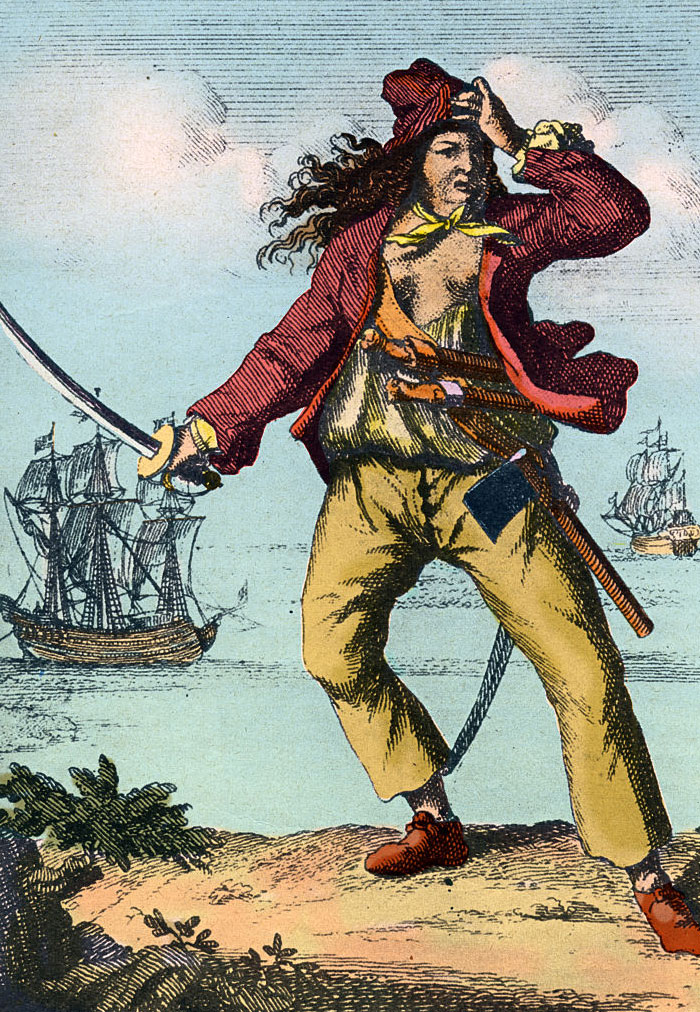
Image credits: Fototeca Storica Nazionale / Getty Images
#2 Black Bart
John Bartholomew Roberts, better known as Black Bart, was born in Wales around 1682. He began his life on the open ocean as a merchant sailor on a slave ship between West Africa and London. However, he quickly realized piracy was a far more lucrative trade.
In 1720, Roberts joined the crew of a ship and became the pirate captain mere weeks later. Over the next two years, Bart put his stamp on the buccaneer world. He was known for his menacing flags and success in pillaging over 400 ships.
Roberts often flew the classic skull and cross bones flag on his ships. However, Bart’s flags featured the white image of himself standing on two skulls. Beneath the skulls were the acronyms ABH (“A Barbadian Head”) and AMH (“A Martiniquan Head”) (Brittanica, 1998) (4).
According to the World History Encyclopedia, the skulls may represent the heads of the governors of Barbados and Martinique because they had both sent ships after Roberts (5).
Roberts was best known for his eccentric style. The French referred to him as the “le jolie rouge,” he often dressed in extravagant finery, including crimson silks and a gold chain with a diamond cross around his neck.
Black Bart’s illustrious career ended abruptly in 1722 off the coast of West Africa. A Royal Navy ship attacked Roberts and his crew, both of which were heavily intoxicated at the time. Grapeshot killed him in battle – ammunition consisting of small iron balls fired together from a cannon.
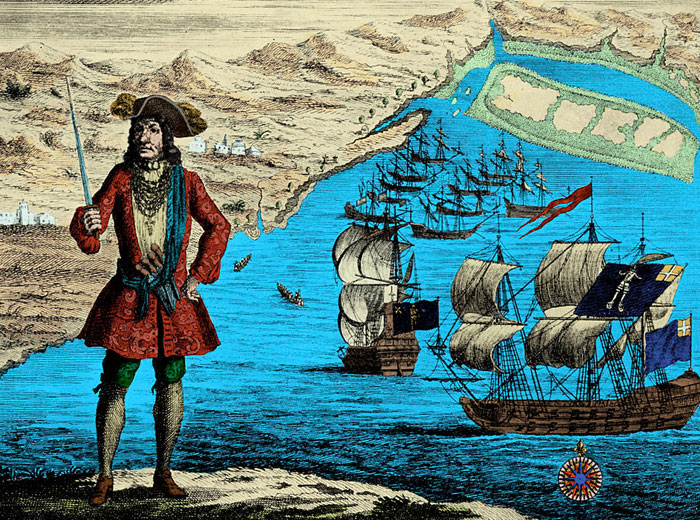
Image credits: Culture Club / Getty Images
#3 Blackbeard
Edward Teach, known as Blackbeard, is perhaps one of history’s most fearsome and famous pirates. Unsurprisingly, Teach sported a braided, long, black beard with braids tied with a bow.
Rumors say he tortured both prisoners and crew, affirming his terrifying reputation. His flag, which featured a skeleton holding a spear pointed at a heart dripping blood, only reinforces the notion (World History Encyclopedia, 2021) (6).
Born around 1680 in Bristol, England, Blackbeard likely served as a privateer for the British government during the War of Spanish Succession (Brittanica, 1989) (7). However, his imposing appearance and successive exploits in piracy have made him memorable.
1717, Blackbeard notably captured a French 40-man gunship, which he renamed Queen Anne’s Revenge. Aboard this ship, he raided and plundered throughout the Caribbean. He strategically captured many ships to increase the power and influence of his fleet.
In 1718, after the Queen Anne’s Revenge wreck, Teach based his operation off the coast of North Carolina, where he collected tolls by force. At the request of Virginia’s governor, a British naval ship under the command of Lieutenant Robert Maynard was sent to deliver justice to Teach and his crew.
Blackbeard’s formidable legend ended on November 22, 1918. In a bloody and gruesome battle, Teach was killed by Maynard himself. Pirate lore suggests Maynard decapitated the buccaneer and hung the head on his ship’s bowsprit. The head was then mounted on a pike by the Virginia governor to warn other pirates (Dolin, 2018) (8).
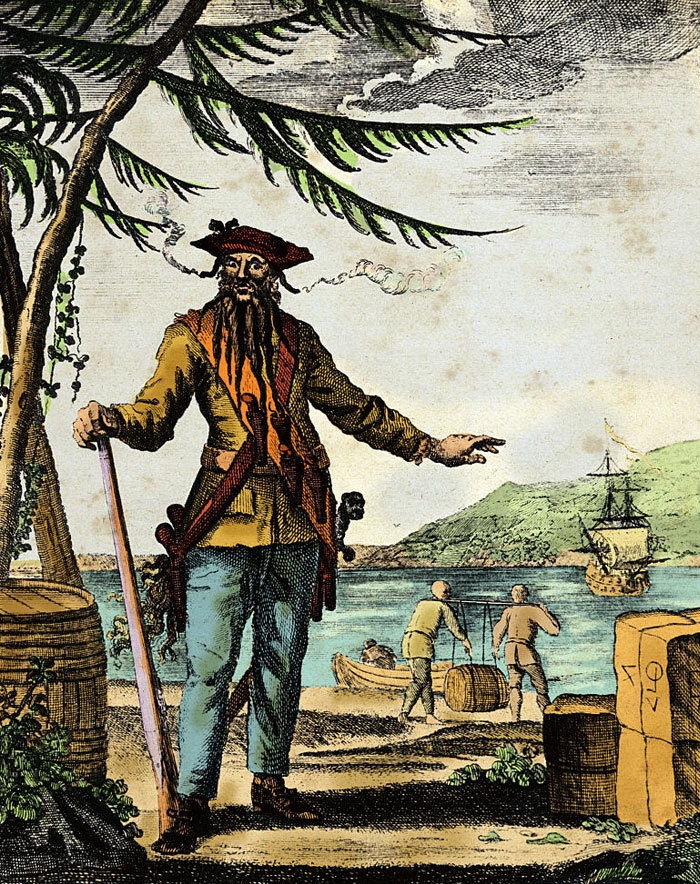
Image credits: Fototeca Storica Nazionale / Getty Images
#4 Black Sam Bellamy
An English pirate, Black Sam Bellamy, was born in Devon, England, around 1689-1690. He sailed to America, seeking fame and fortune as a teenager. He turned to piracy in 1715, during his mid-20s (Guinness World Records, 2023) (9).
Despite only experiencing pirate life for over two years, Captain Sam Bellamy is best known for being one of the most successful and wealthiest pirates of his time.
Bellamy initially worked alongside Blackbeard and his mentor, Benjamin Hornigold, in the Caribbean. He eventually rebelled and began his fleet by stealing one of Hornigold’s ships. Over the next two years, Bellamy would amass 50 ships for his fleet (Brittanica Kids) (10).
The most famous vessel he added to his collection was the Whydah Gally. The Whydah became his flagship, a three-masted, 300-ton ship. Onboard was a fortune of gold, silver, and other valuable cargo (World History Encyclopedia, 2021) (11).
At 28, The Whydah ran aground during a fierce storm off the coast of Cape Cod, Massachusetts. Bellamy drowned alongside most of his crew. Bellamy was said to have accumulated a fortune worth over $140 million in today’s value throughout his short career.
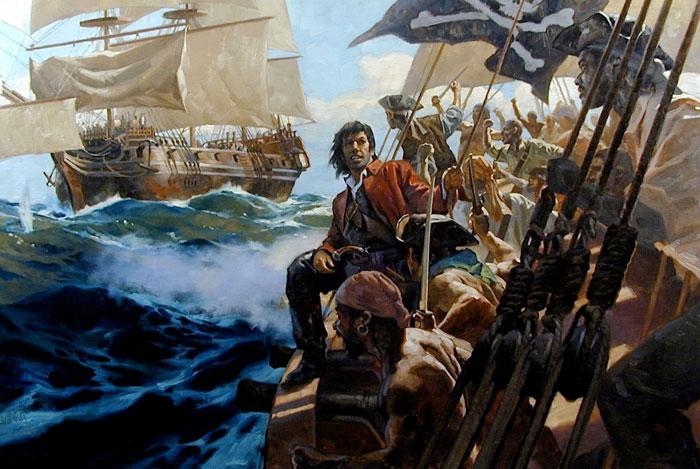
Image credits: https://www.manchess.com/images
#5 Calico Jack
Calico Jack, also known as John Rackham, had a short pirate career spanning only two years. He likely earned his moniker due to his fondness for wearing plain cotton clothing from Calcutta, India (World History Encyclopedia, 2021) (12).
Born around 1680 in England, Rackham made a name for himself by welcoming two women pirates to sail with him — one of whom he married.
In 1718, Rackham started as the quartermaster for Charles Vane. After Vane chose not to plunder a French Man-O-War ship in The Bahamas, Rackham assumed the captaincy of Vane’s ships following a somewhat democratic vote by the crew. Vane was given the smaller of the two vessels in the fleet and sent on his way (Sky History) (13).
Over the next year, Rackham pillaged and ransacked his way through the Caribbean. At one point, he unexpectedly earned a pardon from the governor of The Bahamas after claiming he was forced into piracy by Vane. Rackham attempted to settle in Nassau but soon ran out of money and returned to buccaneering.
At this point, Rackham met the married Anne Bonny. Because of harmful superstitions about having women aboard ships – and because she was already married – Bonny was forced to sneak onboard dressed as a man. Rackham also welcomed Mary Read, another woman who donned men’s clothing.
Calico Jack’s career ended abruptly in Jamaica in 1720. He was pursued and captured by a ship sent by the governor of Jamaica to apprehend Rackham. Despite pleading guilty, the evidence was overwhelming. He was quickly convicted of piracy and executed by hanging.
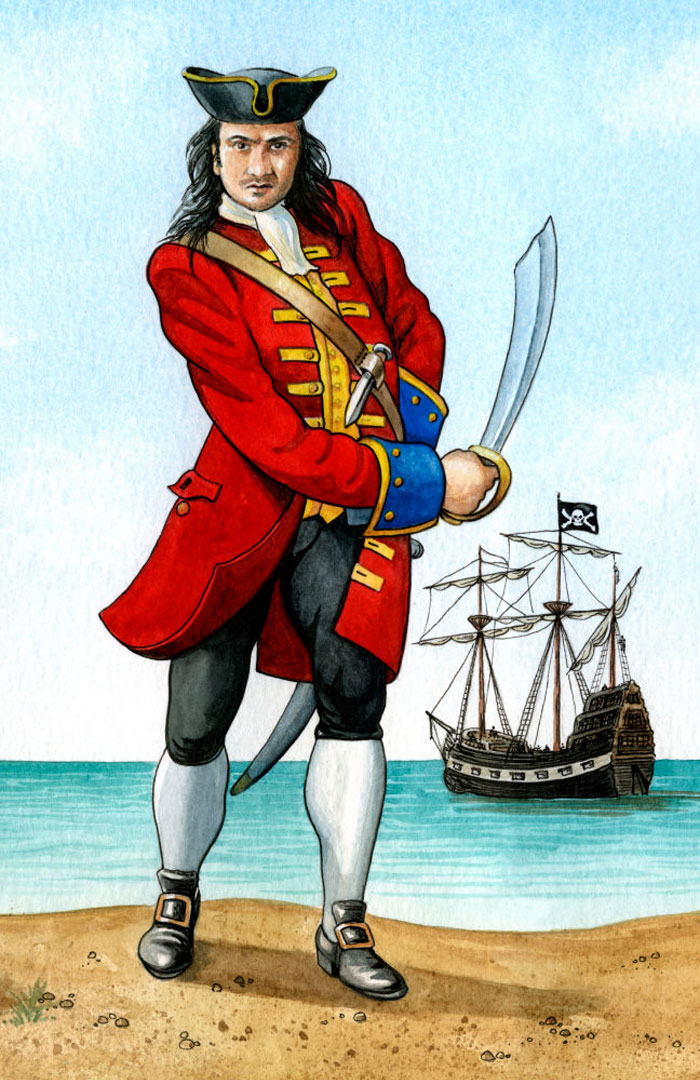
Image credits: Print Collector / Getty Images
#6 Captain Kidd
Captain William Kidd, born in Scotland around 1645, is best known in pirate history for his unfortunate luck. In 1689, his career on the high seas began with privateering on the eastern coast of the US and the Caribbean.
During this time, the king gave him two commissions: to suppress piracy and to act as a privateer against the French (Thurrock) (14). Over the next few years, Kidd continued to act as a privateer. However, he struggled to find suitable men for a crew and was forced to acquire buccaneers.
In 1697, he became a pirate after pressure from his crew, who wanted better spoils and began attacking legitimate merchant ships (World History Encyclopedia, 2021) (15). According to Historic UK, unbeknownst to Kidd, piracy had been deemed a criminal act around the same time (16).
In 1699, Kidd was in Anguilla. He discovered he was a wanted man (Brittanica, 1998) (17). To resolve this, he sent half of his booty back to the British governor in New York — the gesture did nothing to pardon him.
He was promptly arrested in Boston and deported to London to stand trial. Kidd had no support from the governor of New England, who had previously financed his privateering.
Before his detention, Kidd buried some of his treasure in several locations. Some places were disclosed during his arrest, but there are rumors that some of his loot remains hidden along the East Coasts of the United States and India.
In 1701, Kidd was tried and convicted for the murder of William Moore, as well as several counts of piracy. Despite his legitimate privateering efforts, many speculate his trial was rigged to show the harsh new stance against pirates. Kidd was executed as an example to others.
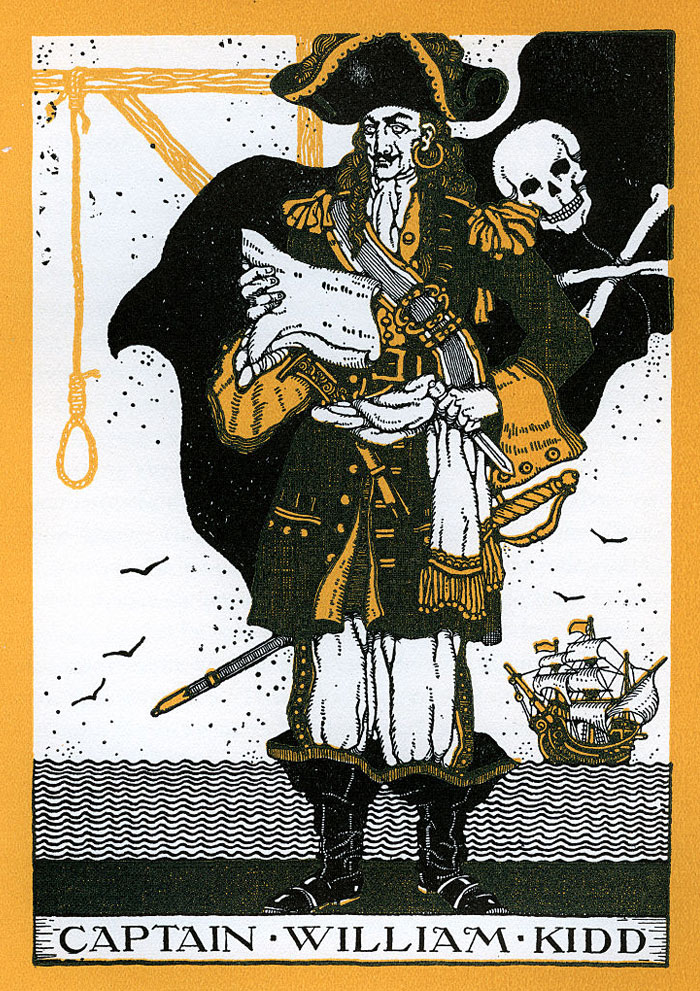
Image credits: GraphicaArtis / Getty Images
#7 Charles Vane
Captain Charles Vane is best known for cruel punishment, being ousted by Captain John Rackham (Calico Jack), and stubbornly refusing the king’s pardon.
Not much is known about Vane’s early life. His career began in 1716, and he was moderately successful for a short time as a Caribbean pirate (World History Encyclopedia, 2021) (18).
In May 1718, an escaped crew member of a captured ship spoke to the governor of Bermuda. He detailed Vane’s attack on his boat and the subsequent horrendous treatment of the crew. The tale spread with others, adding to Vane’s brutal image.
In August 1718, Vane was offered a pardon by the governor of The Bahamas. However, Vane stubbornly rejected the offer. During his escape, he even fired a parting shot from a cannon.
By November 1718, Vane was accused of not fairly sharing his spoils with his men. Eventually, his crew voted him out of his captaincy. They replaced him with his former quartermaster, John Rackham (Calico Jack). Fortunately, Vane was allowed to leave and was given a smaller ship and crew.
At this point, Vane’s luck had run out. His ship eventually wrecked during a hurricane off the coast of Honduras. A passing boat was able to help the stranded men. However, the captain of the vessel, a man named Holford, knew Vane. Vane had previously attempted to take over one of his ships (The National Archives, 2017) (19).
Upon reaching Port Royal, Jamaica, Vane was detained by Holford and handed over to the authorities. In 1721, Vane was tried, convicted, and hanged for crimes of piracy.
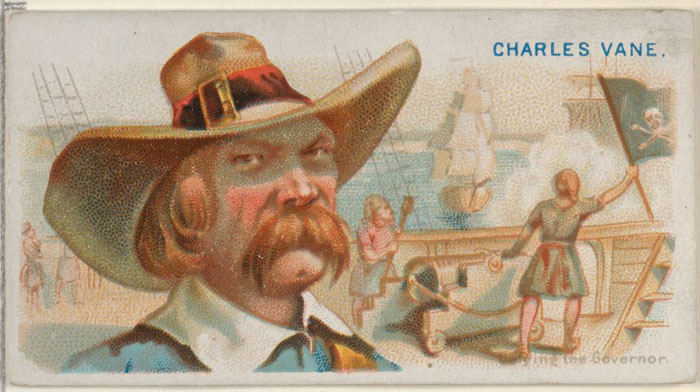
Image credits: Sepia Times / Getty Images
#8 Ching Shih
Also known as Madame Cheung, Ching Shih was one of the most successful female pirates. Born in 1775 in Guangdong, China, Shih’s world was one of poverty. At a young age, she was forced into prostitution, working in floating brothels. However, her beauty and poise attracted high-end clients, including royal courtiers.
1801, Ching Shih married Zheng Yi, a pirate commander. Her name changed to Zheng Yi Sao, meaning “the wife of Cheng.” Before they were married, Shih demanded 50% of Yi’s profits and partial control of his fleet, which he agreed to (History Hit, 2021) (20).
Over time, Shih and her husband created a pirate confederation by solidifying smaller gangs. According to Richard Glasspoole’s book “Mr. Glasspoole and the Chinese Pirates,” By 1804, their Red Flag Fleet had amassed 400 junk ships with over 70,000 men, organized into six smaller squadrons (21).
During this time, Shih, a protofeminist, introduced rules to help protect fellow women. For example, men would be executed for the ravishment of any female captives or marital infidelity. According to Dian Murray’s book "One Woman's Rise to Power: Cheng I's Wife and the Pirates,” one prisoner described Shih as “[a remarkable woman who] used her authority with firmness and discretion” (22).
At some point, Yi and Shih adopted a man in his mid-20s named Chang Pao (sometimes referred to as Cheung Po or Zhang Bao Zai) (BBC, 2022) (23). Pao became second in command. It is thought he also engaged in affairs with both Yi and Shih.
In November 1807, Yi died. However, Shih readily took control. She also married her adopted son, Pao. Under her leadership, the Red Flag Fleet controlled most of the ships in the South China Sea. Furthermore, Shih’s fleet defeated the Qing dynasty’s navy — a considerable embarrassment for the emperor.
In 1810, the Red Flag Fleet was defeated by the Portuguese navy. Fortunately, the Chinese government offered Shih amnesty, which she accepted. She died at the age of 69, purportedly running a brothel.
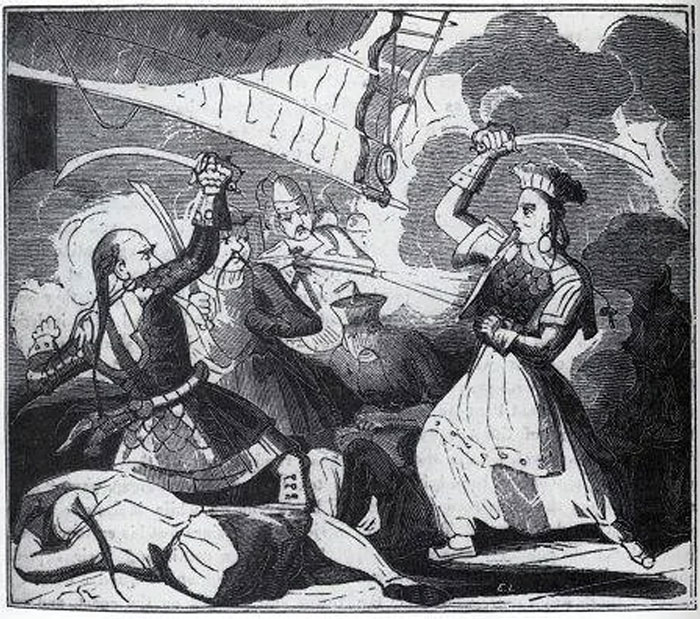
#9 Edward Low
Little is known about Edward Low’s early life. It is said that he and his brother engaged in cheating and stealing as children on the streets of London, where he was born. (World History Encyclopedia, 2021) (24).
Low’s career as a pirate began in the 1720s. In December 1721, on the way to Honduras on a merchant sloop, Low and other crew members rebelled against the captain. They took the ship and began a life of robbing on the high seas, with Low voted as captain.
After briefly joining forces with another pirate on the Caribbean waters, Low decided to target ships off the coast of North America. Low was well known for his brutal treatment of rival crews. His flag featured a red skeleton against a black background to reinforce this barbaric image.
Even those who surrendered peacefully were not exempt from Low’s vicious wrath. Some stories detail vicious attacks that suggest Low and his crew enjoyed torturing their victims.
In 1724, after reports of mental instability, Low was supposedly marooned by his crew on a desert island, never to be seen again. However, some accounts suggest he may have been captured and hanged in Martinique.
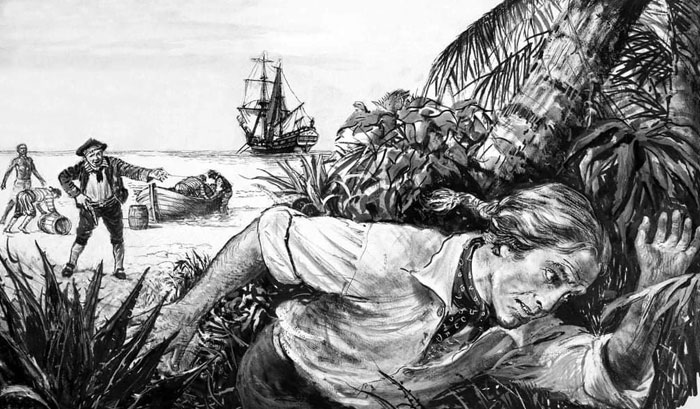
#10 Sir Francis Drake
Sir Francis Drake was born in Devon, England, around 1542. He is best known as the first Englishman to circumnavigate the globe. In 1567, Drake sailed to West Africa to capture and collect captives.
Along the way, his crew would attack other ships to relieve them of their slaves. At one point, he and his crew (many of which were killed) were captured by the Spanish in New Spain while trying to sell enslaved people. Drake’s hatred of the Spanish began (History, 2009) (25).
Eventually, Drake’s successes caught the attention of Queen Elizabeth I. She granted him commissions to privateer against Spanish ships in the Caribbean Sea, which he enthusiastically did. The queen tasked Drake with circumnavigating the globe. However, his journey was a stealthy mission authorized by her to raid the Spanish.
Upon his return in 1580, Queen Elizabeth I knighted Drake aboard his ship per the University of Plymouth, and he notoriously helped defend England against the Spanish Armada in 1588 (World History Encyclopedia, 2020) (26) (27).
Following this victory, Drake was assigned to usurp possessions from the Spanish in the Caribbean in 1596. Despite their bravery, the Spanish defended themselves successfully, and Drake was ultimately unsuccessful. He later died from fever and dysentery.
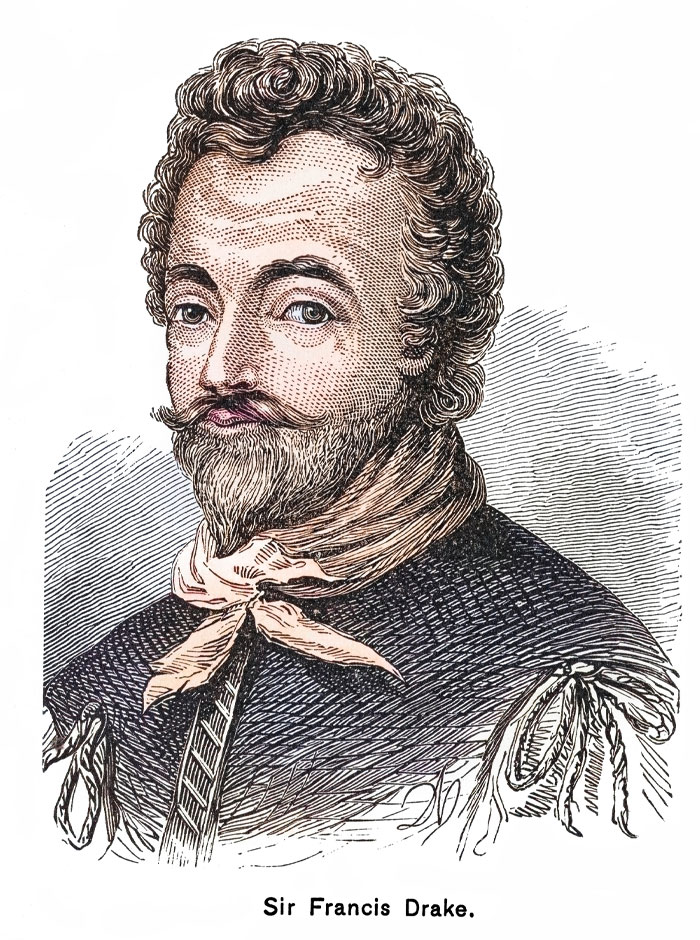
Image credits: mikroman6 / Getty Images
#11 Grace O’Malley
Born around 1530 in the West of Ireland to an Irish Chieftain, Grace O’Malley is often called the Pirate Queen. Legend has it that her seafaring father would not allow her to join his crew because her hair was too long and would get caught in the ship’s rigging. O’Malley’s response was to cut it all off, and her father allowed her to come aboard (World History Encyclopedia) (28).
At 16, O’Malley wed Donal O’Flaherty, a man from another powerful seafaring family. She bore him three children (Britannica Kids) (29). O’Flaherty was killed by another clan – The Joyces.
After a failed attempt by the Joyce clan to apprehend O’Flaherty’s castle – because Grace bravely fought them off – she returned to her family’s land with her three children. Interestingly, her husband’s men swore allegiance to her and went with her. After his passing, O’Malley also took over her father’s role as clan leader.
Following her second marriage, O’Malley’s standing as a prominent figure in Ireland soared. However, as England’s grip on Ireland tightened, O’Malley and several family members found themselves imprisoned on charges of treason.
However, she successfully petitioned the crown for an audience with Queen Elizabeth I in 1593. A deal was struck whereby Grace would no longer oppose the English. O’Malley secured the release of her family members and the return of income from some of her deceased husband’s land.
For the remainder of her life, O’Malley continued to rebel against the English more subtly. For instance, she lent ships to Irish rebels and encouraged her son to fight for Elizabeth I. Today, O’Malley is seen as one of the forebearers of Irish independence.
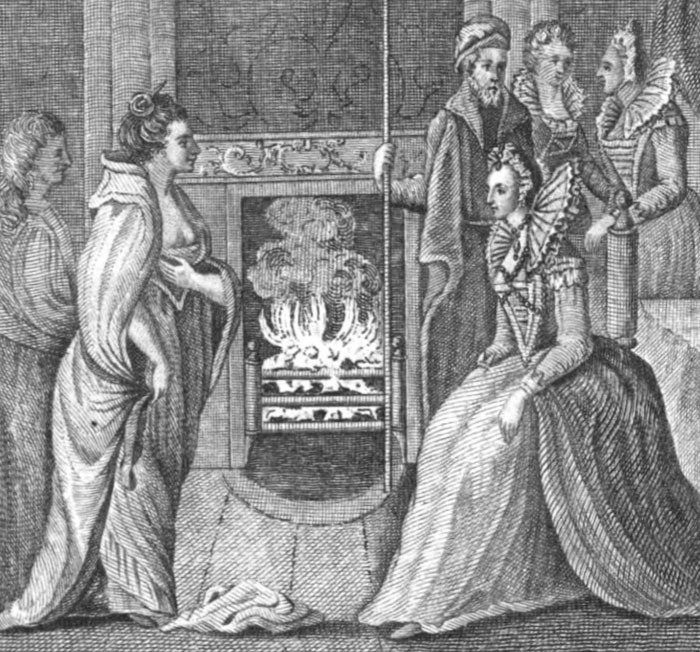
#12 Sir Henry Morgan
Sir Henry Morgan is one of the most notorious pirates in history. He is most recognizable from his image on Captain Morgan’s Spiced Rum. While Morgan’s origins are vague, his career as one of the most famous buccaneers is one of legend.
Born around 1635 in Wales, Morgan moved to Jamaica in 1655. Brittanica records suggest Morgan was part of an expedition that liberated Jamaica from Spain’s control, making it an English colony (30). During that time, Morgan acted as a privateer against the Spanish (World History Encyclopedia, 2021) (31).
In 1668, Morgan successfully ransacked the city of Portobelo in Panama — a strategic holding of the Spanish. In 1670, with the support of a large fleet, Morgan pillaged and burned down a significant city in Spain’s American domain – what is now Panama City. The story goes on to Morgan deserting his followers and taking most of the stolen booty for himself.
Unbeknownst to Morgan, the attack on Panama City happened after England and Spain had reached a peaceful agreement. This led to Morgan’s arrest, trial, and imprisonment for piracy in 1672 (Historic UK) (32).
After relations worsened again between England and Spain, Morgan was eventually released, knighted, and named lieutenant governor of Jamaica in 1674. He held this position until 1682. Until he died in 1688, Morgan owned many forced workers and three plantations (Centre for the Study of Legacies of British Slavery) (33).
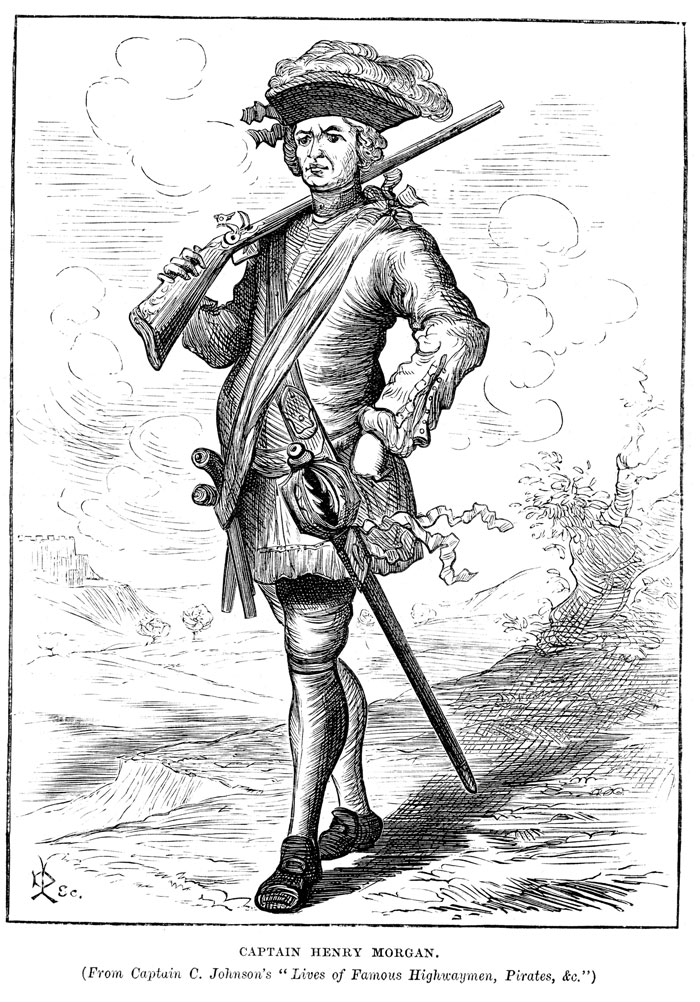
Image credits: duncan1890 / Getty Images
#13 Mary Read
Like Anne Bonny, Mary Read was one of two famous female pirates dressed like a man aboard John Rackham’s ship. Read was an illegitimate child. She was born around 1690 in Plymouth, England, to a young widow. After her legitimate half-brother’s death, her mother dressed Read as the boy to ensure they received payment from the deceased husband’s parents (Historic UK) (34).
Read continued to dress as a male for most of her life. In this disguise, she entered military service for both England and Flanders. Eventually, Read fell in love with a fellow soldier, who she revealed her true identity to and subsequently married (Brittanica, 2017) (35).
After her husband’s death, Read returned to dressing as a man and began her life on the high seas. Around the same time as Bonny, 1718-19, Read joined Rackham’s crew. While Bonny openly acknowledged her gender, Read kept hers hidden, although it is suspected that many knew.
Anne Bonny and Mary Read developed a close friendship and were both seen as fierce fighters. Read was rumored to have continued fighting when other crew members, including Rackham, had surrendered. Read, along with many crew members, was convicted of piracy in 1720.
However, Read avoided execution like Bonny by claiming she was pregnant. Read died in prison 1721 from a fever (World History Encyclopedia, 2021) (36).
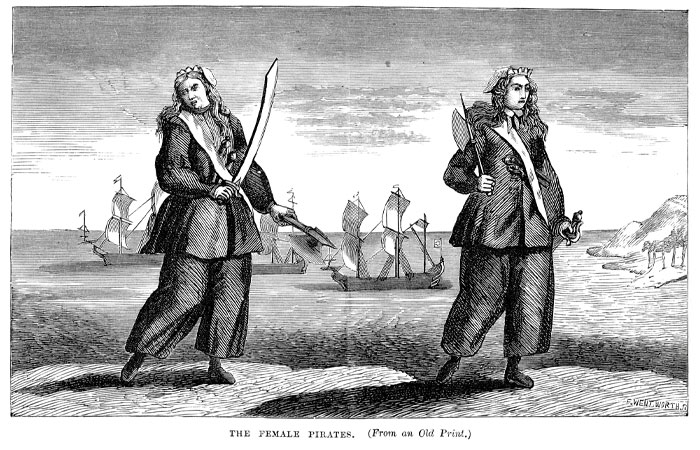
Image credits: duncan1890 / Getty Images
FAQ
What is the difference between pirates and privateers?
A pirate was an outlaw who pillaged for their profit. A privateer was legally sanctioned to steal by a government or monarch.
Who was the deadliest pirate?
The deadliest title could either go to Blackbeard or Edward Low. The death tolls of each man were not accurately recorded, so historians often have to base their assumptions on the accounts of witnesses.
Who was the most powerful pirate?
Surprisingly, Ching Shih is considered one of the most powerful pirates in history. Her massive fleet’s skillful and organized management was impressive for any pirate, particularly a woman.
Who is the most famous modern-day pirate?
Unlike during the Golden Age of Piracy, modern-day pirates don’t enjoy individual notoriety. Somali pirates were a real threat about ten years ago and are starting to make their presence known again (BBC, 2024) (37).
Who is the most famous pirate ever?
Blackbeard is likely the most famous real pirate of all time, based on recognition alone. Captain Morgan is a close second, primarily due to the image on the bottles of rum with his name.
Who are the most famous fictional pirates?
Captain Jack Sparrow (Disney’s Pirates of the Caribbean), Captain Hook and Mr. Smee (“Peter Pan” by J.M. Barrie), and Long John Silver (“Treasure Island” by Robert Louis Stevenson).
References
- Johnson, Charles. “A General History of the Pyrates.” 1724 | https://www.gutenberg.org/files/40580/40580-h/40580-h.htm
- Pallardy, Richard. “Anne Bonny.” Brittanica. September 2, 2010 | https://www.britannica.com/biography/Anne-Bonny
- Cartwright, Mark. “Anne Bonney.” World History Encyclopedia. August 23, 2021 | https://www.worldhistory.org/Anne_Bonny/
- The Editors of Encyclopedia Brittanica. “Bartholomew Roberts.” Brittanica. July 20, 1998 | https://www.britannica.com/biography/Bartholomew-Roberts
- Cartwright, Mark. “Batholomew Roberts.” World History Encyclopedia. September 7, 2021 | https://www.worldhistory.org/Bartholomew_Roberts/
- Cartwright, Mark. “Blackbeard.” World History Encyclopedia. August 19, 2021 | https://www.worldhistory.org/Blackbeard/
- The Editors of Encyclopedia Brittanica. “Blackbeard.” Brittanica. July 20, 1989 | https://www.britannica.com/biography/Blackbeard
- Dolin, Eric J. “Black Flags, Blue WatersThe Epic History of America’s Most Notorious Pirates.” September 21, 2018 | https://www.amazon.co.uk/Black-Flags-Blue-Waters-Notorious/dp/1631492101
- Pilastro, Eleonara. “Sam Bellamy became world’s richest pirate despite ruling oceans for just two years.” Guinness World Records. November 30, 2023. | https://www.guinnessworldrecords.com/news/2023/11/sam-bellamy-became-worlds-richest-pirate-despite-ruling-oceans-for-just-two-years-761798
- “Pirates and Piracy.” Brittanica Kids. | https://kids.britannica.com/students/article/pirates-and-piracy/276436#:~:text=British+pirate+Sam+Bellamy%2C+also,from+more+than+50+ships.
- Cartwright, Mark. “Samuel Bellamy.” World History Encyclopedia. September 30, 2021 | https://www.worldhistory.org/Samuel_Bellamy/
- Cartwright, Mark. “Calico Jack.” World History Encyclopedia. September 21, 2021 | https://www.worldhistory.org/Calico_Jack/
- Perry, BP. “The real Captain Jack: The life of infamous pirate Calico Jack Rackham.” Sky History. | https://www.history.co.uk/articles/the-life-of-pirate-calcio-jack-rackham
- “Captain Kidd, the Tilbury connection.” Thurrock.gov.uk. | https://www.thurrock.gov.uk/thurrock-historical-people/captain-kidd-tilbury-connection
- Cartwright, Mark. “Captain Kidd.” World History Encyclopedia. August 25, 2021 | https://www.worldhistory.org/Captain_Kidd/
- Johnson, Ben. “Captain William Kidd.” Historic UK. | https://www.historic-uk.com/HistoryUK/HistoryofScotland/Captain-William-Kidd/
- The Editors of Encyclopedia Brittanica. “William Kidd.” Brittanica. July 20, 1998 | https://www.britannica.com/biography/William-Kidd
- Cartwright, Mark. “Charles Vane.” World History Encyclopedia. September 2, 2021 | https://www.worldhistory.org/Charles_Vane/
- McGrath, Joseph. “The fates of six real-life pirates of the Caribbean.” The National Archives blog. May 31, 2017. | https://blog.nationalarchives.gov.uk/fates-six-real-life-pirates-caribbean/
- Davidson, Lucy. “10 Facts About Ching Shih, China’s Pirate Queen.” HistoryHit. November 24, 2021. | https://www.historyhit.com/facts-about-ching-shih-chinas-pirate-queen/
- Glasspoole, Richard. “Mr. Glasspoole and the Chinese Pirates[…].” The Golden Cockerel Press, 1935. | https://nla.gov.au/nla.obj-2691462696/view?partId=nla.obj-2691495636
- Murray, Dian. “One Woman’s Rise to Power: Cheng I’s Wife and the Pirates.” Historical Reflections / Réflexions Historiques 8, no. 3. 1981. | https://www.jstor.org/stable/41298765
- Nagouse, Emma. “Zheng Yi Sao: The most successful pirate in history.” BBC, June 22, 2022. | https://www.bbc.co.uk/videos/ckg11ny2g28o
- Cartwright, Mark. “Edward Low.” World History Encyclopedia. September 22, 2021 | https://www.worldhistory.org/Edward_Low/
- History.com Editors. “Sir Francis Drake.” History.com. November 9, 2009 | https://www.history.com/topics/exploration/sir-francis-drake
- Murphy, Dr. Elaine. “More pirate than patriot? Examining Sir Francis Drake’s legacy of exploration.” Plymouth University. | https://www.plymouth.ac.uk/courses/undergraduate/ba-history/elaine-murphy
- Cartwright, Mark. “Francis Drake.” World History Encyclopedia. June 25, 2020 | https://www.worldhistory.org/Francis_Drake/
- Mark, Joshua J. “Grace O’Malley.” World History Encyclopedia. November 1, 2021 | https://www.worldhistory.org/Grace_O’Malley/
- “Grace O’Malley.” Brittanica Kids. | https://kids.britannica.com/kids/article/Grace-OMalley/487538
- The Editors of Encyclopedia Brittanica. “Sir Henry Morgan.” Brittanica. July 20, 1998 | https://www.britannica.com/biography/Henry-Morgan-Welsh-buccaneer
- Cartwright, Mark. “Henry Morgan.” World History Encyclopedia. October 25, 2021 | https://www.worldhistory.org/Henry_Morgan/
- Johnson, Ben. “Sir Henry Morgan.” Historic UK. | https://www.historic-uk.com/HistoryUK/HistoryofWales/Sir-Henry-Morgan/
- “Sir Henry Morgan.” Centre for the Study of Legacies of British Slavery. | https://www.ucl.ac.uk/lbs/person/view/2146662323
- Codlin, Robyn. “Mary Read the Pirate.” Historic UK. | https://www.historic-uk.com/HistoryUK/HistoryofEngland/Mary-Read-Pirate
- Tikkanen, Amy. “Mary Read.” Brittanica. August 2, 2017 | https://www.britannica.com/biography/Mary-Read
- Cartwright, Mark. “Mary Read.” World History Encyclopedia. October 5, 2021 | https://www.worldhistory.org/Mary_Read/
- Chibelushi, Wedaeli. “Somalia piracy: Are we witnessing its return off the country’s coast?” BBC. February 3, 2024 | https://www.bbc.co.uk/news/world-africa-68155471
[ad_2]
Source link
























